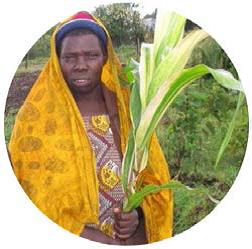Control and Management
 How can MLN be controlled?
How can MLN be controlled?
Based on CLN/MLN management experiences in the USA, rigorous disease management practices in seed production plots, including use of resistant varieties, controlling weeds/alternate hosts, keeping unnecessary machines/people out of the field, controlling insect-vectors using appropriate insecticide (at weekly intervals), and having adequate isolation from MLN-infected fields, can prevent the spread of the disease. Because individual plants with MCMV or SCMV alone show milder symptoms, seed production fields must be carefully inspected and plants that appear infected removed immediately.
How can farmers prevent MLN in their fields?
- MLN does not occur on crops other than maize; so avoid growing maize after maize. Diversify your farm enterprise by planting different crops each season.
- Do not plant a new maize crop near an infected field. Wind-blown insect vectors can transmit the disease from the infected field to the new crop.
- Plant maize at the onset of the main rainy season, rather than during the short rain season; this creates a break between maize crops and interrupts the disease cycle.
- Weed fields regularly to eliminate alternate hosts for insect vectors.
- Use maize varieties that are resistant to MLN.
What should farmers do if they find MLN in their fields?
- Immediately remove diseased plants from your fields. You can feed the leaves to livestock.
- Do not allow humans or animals to eat infected ears or grains, which may contain secondary fungal infections and harmful mycotoxins. Burn infected ears and grains.
